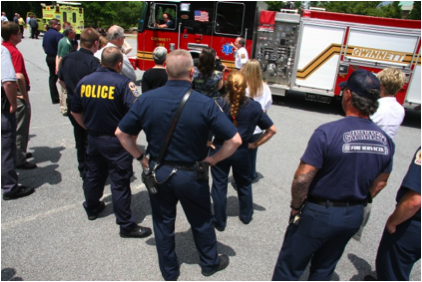Federal Highway Administration:
Training Trainers to Launch the Traffic Incident Management Responder Course
The Federal Highway Administration (FHWA) of the U.S. Department of Transportation continues to train trainers in all U.S. States and two U.S. territories to launch classroom sessions of the newly released Traffic Incident Management (TIM) Responder Basic Training Course. To date, almost 5,200 fire, law enforcement and transportation TIM experts have received training on how to implement the course in a classroom setting. The FHWA highly encourages Safety Service Patrol professionals to attend a course offering in their area.
What Is the Course?
 A Congressionally mandated effort managed by the Transportation Research Board (TRB), the American Association of State Highway Officials (AASHTO), and the FHWA through the Second Strategic Highway Research Program (SHRP 2) resulted in a Traffic Incident Responder training course to address on-scene operations and management. This multi-disciplinary training course promotes a shared understanding of the requirements for quick clearance and for safeguarding responders and motorists. FHWA produced a 2-day Train-the-Trainer course and is traveling around the Nation training TIM experts to conduct the classroom-based course. As of April 9, 2013, a little over 1,200 TIM law enforcement, fire and transportation experts received the training. These trained trainers have begun conducting training for TIM practitioners in 18 States and reached nearly 4,000 practitioners. The SHRP2 effort is producing an e-Learning version that will allow independent training. However, FHWA recommends that the classroom training be taken when possible due to the intangible benefits of training with those disciplines a participant may not deal with except at the incident scene. This online course will be ready for release within a year. Finally, a fourth product being produced will allow for an evaluation of how the course is impacting TIM operations at a local level. This will be rolled out in 2015.
A Congressionally mandated effort managed by the Transportation Research Board (TRB), the American Association of State Highway Officials (AASHTO), and the FHWA through the Second Strategic Highway Research Program (SHRP 2) resulted in a Traffic Incident Responder training course to address on-scene operations and management. This multi-disciplinary training course promotes a shared understanding of the requirements for quick clearance and for safeguarding responders and motorists. FHWA produced a 2-day Train-the-Trainer course and is traveling around the Nation training TIM experts to conduct the classroom-based course. As of April 9, 2013, a little over 1,200 TIM law enforcement, fire and transportation experts received the training. These trained trainers have begun conducting training for TIM practitioners in 18 States and reached nearly 4,000 practitioners. The SHRP2 effort is producing an e-Learning version that will allow independent training. However, FHWA recommends that the classroom training be taken when possible due to the intangible benefits of training with those disciplines a participant may not deal with except at the incident scene. This online course will be ready for release within a year. Finally, a fourth product being produced will allow for an evaluation of how the course is impacting TIM operations at a local level. This will be rolled out in 2015.
What Are the Training Objectives?
The new multi-agency National Traffic Incident Management Responder training course equips responders with a common set of core competencies and assists them in achieving the TIM National Unified Goal of strengthening TIM programs in the areas of: Responder Safety; Safe, Quick Clearance; and Prompt, Reliable, and Interoperable Communications. The course incorporates flexible delivery approaches, such as delivery through Law Enforcement, Fire and other Academies as well as e-Learning, to offer the maximum number of opportunities to take the course and to obtain refresher training as needed. Based on post-delivery feedback, trainers who evaluated the course indicate that its strengths and potential benefits include:
- Promoting more effective multi-agency, coordinated, and planned incident response.
- Improving responder safety.
- Improving travel-time reliability for person and freight trips on the Nation’s highways by improving incident clearance time.
- Reducing congestion, collisions, and delays caused by secondary crashes.
Who Should Attend?
 All professionals that respond to incidents on the roadways, bridges and tunnels should take this course in spite of experience. FHWA already provides training for mid-level managers through its TIM Advanced Workshops and conducts awareness briefings with executive decision makers from transportation, law enforcement, fire and rescue, emergency medical services, and other senior political officials. This is the course that provides good practices, common terminology, tools and doctrine that is endorsed by FHWA, AASHTO, TRB, the International Association of Fire Chiefs, the National Volunteer Fire Council and the International Chiefs of Police. We especially encourage Safety Service Patrols, traffic management center operations staff, and other transportation capabilities that conduct TIM planning and operations.
All professionals that respond to incidents on the roadways, bridges and tunnels should take this course in spite of experience. FHWA already provides training for mid-level managers through its TIM Advanced Workshops and conducts awareness briefings with executive decision makers from transportation, law enforcement, fire and rescue, emergency medical services, and other senior political officials. This is the course that provides good practices, common terminology, tools and doctrine that is endorsed by FHWA, AASHTO, TRB, the International Association of Fire Chiefs, the National Volunteer Fire Council and the International Chiefs of Police. We especially encourage Safety Service Patrols, traffic management center operations staff, and other transportation capabilities that conduct TIM planning and operations.
Who Benefits?
Governors, transportation leaders, Safety Service Patrol specialists, police, firefighters, towers, emergency medical services professionals, public works practitioners, and other public safety entities across the country can save money, time, and lives by championing full-scale deployment of these innovative training courses focused on traffic incident management (TIM).
Who Developed It?
SHRP 2 was created by Congress to address the challenges of moving people and goods efficiently and safely on the Nation’s highways. This short-term research program addresses four strategic focus areas:
- Safety – The role of human behavior in highway safety.
- Renewal – More efficient highway project delivery.
- Reliability – Congestion reduction through improved travel time.
- Capacity – Improved integration of community, economic, and environmental considerations for new highway capacity.
The partners developed this course as a part of the Reliability track, but it also addresses Safety as well.
The facilitating agencies, TRB, AASHTO and FHWA (which is responsible for implementing the course), assembled the leading authorities on TIM from the law enforcement, fire, towing, transportation and other disciplines to shape the course.
Key to Success
In order to effectively strengthen TIM activities, FHWA believes that the training courses must reach a majority of the Nation’s TIM responders. You can affect change by encouraging your staff and counterparts to attend the TIM Responder Training course offered in your State. To learn when sessions will be offered, refer to the Traffic Incident & Events Management Website. For more information, please feel free to contact Kimberly C. Vásconez, TI&EM Team Leader, at TI&EM@dot.gov or by phone at 202-366-1559.
